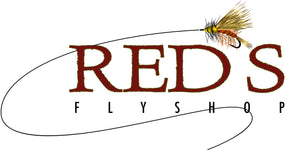Generate More Strikes by Twitching and Skating Your Dry Fly
One thing that makes fly fishing so intriguing is that YOU are in control of generating your own action. If you enjoy being at the complete mercy of the fish... stick with a bobber, a worm, and a 6-pack of warm beer.
If you like to generate the action like we do, take the game into your own hands with this week's video tip. Finish out the big dry fly season by getting proficient at skating, twitching, and generating small ripples with your dry fly. The shadows and tiny ripples you can generate is often the difference maker in triggering strikes.
Good casting is a critical component of this as well. There are a few comments in the video about generating enough line speed in your backcast to adequately dry off your fly, AND help it land delicately just like the real thing.
Drownings, Shark Attacks, and Piranhas
When a big bug like an October Caddis, Crane Fly, or a Stonefly hits the water it's a struggle for survival. One of the three things happens in short order:
- Bug quickly scurries to shore or a tree branch. Often they are only in the water for several seconds as they know the water is dangerous territory.
- Bug gets eaten (often by a pack of minnows devouring it piranhas).
- Bug drowns in a whirlpool.
The point here is that mile-long dead drifts are not as believable as delicately dropping a fly within a trout's strike zone, and following it up with a twitch, ripple, and shadowy ring to help sell it.
Tips Discussed in the Video
- Keep your tippet up on the surface (if the tippet sinks, your fly will nose dive).
- Grease your leader.
- Don't move the fly by stripping line, do it be elevating the rod tip.
- Shake and vibrate the line to work the line/leader up on top of the surface tension.
- Less is more. Remember, it's only an insect. They skitter, not plow.
- The "landing" of the fly is critical. Work on delivering casts in which the fly delicately parachutes onto the surface. It floats better and can generate instant strikes.
- Line speed in the initial backcast helps the fly dry out faster, therefore float better and skitter properly
- Skitter and skate the fly slightly upstream. This helps it ride high.
- It's the "ripples" that sell it. Not the actual movement. A savvy angler gets the fly to wobble in place generating rings while near stationary.

